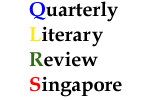 |
 |
|||||||||||||
|
By Cyril Wong
The Last Uncle
A critic, who was also a teacher of creative-writing, in a monthly edition of Poetry revealed that younger readers of Louise Glück’s latest volume of verse, The Seven Ages, tended to dislike the Pulitzer Prize-winning poet’s austere preoccupation with old age and dying. Less dark is Pastan’s latest offering, The Last Uncle, which steers more towards optimism with occasional and subtle revelations of bitterness and grief, as compared to Glück. But younger readers more obsessed with neurasthenic verse bordering on hysteria and heart-stopping imagery (à la Sharon Olds) would still find little to appreciate in Pastan’s deceptively calm perspective. Also, her often cheerful but modest lyricism might put off some poet-readers eager to be impressed by more incredulous metaphorical connections and mind-boggling, philosophical allusions. Such readers would get pretty bored by the middle of this book and also with Carnival Evening, Pastan's earlier collection of selected poems.
Pastan’s images do more than startle now and then, while her themes about family and the regretful passing of time. In the title poem ‘The Last Uncle’, she refers to the “black limo” of her uncle’s “funeral skiff” during his funeral and how she is one of the “elders now / with our torn scraps / of history / alone on the maples shore / of this raw, new century.” Pastan draws her images from Impressionist to Expressionist art as well, and with humble success, as in the first poem about Edvard Munch’s woodcut, where the conclusion she draws from the work is a powerful statement on the bond between our mortality and art:
If death is everywhere we look,
The central theme, a link between the ineluctable processes of aging, death, and the loss of an earlier generation to nature and to what she experiences on her European excursions, resonates throughout the book like a persistent echo. In the poem ‘Ghiaccio’, for example, she draws a rich connection between breaking her ankle while falling in Italy and an ancient place where antique human bones were found, like “so many pieces in an intricate puzzle now / but vulnerable once, and ordinary as mine.” The poem ends with humour when she candidly reveals how she tries “to think of the Italian word for ice.”
Two of the best poems in the book are ‘White Lies’ and ‘After a Long Absence, I Return to a Site of Former Happiness’. In the former, the poet understands how fact and fiction may “smile and embrace - / identical twins, / separated at birth”, in relation to the white lies born of touching necessity and faith between lovers, as when one openly swears to love the other forever. Contingency and desire are the only true constants – the desire to love and be loved, as summed up in the closing lines:
You say I still look beautiful.
In ‘After a Long Absence, I Return to a Site of Former Happiness’, a self-conscious awareness of human incompleteness and the desire for transcendence resonate with a personal gravity that is close to unforgettable. The poems starts, “This is what the world will be / without me” and goes on to paint a picture of regret and bitterness at “how easily [we’ll] be replaced on earth.” This is one of the central poems in the book which more than memorably conveys her obsession with the nature of our mortality.
Before, I mentioned the critic who wrote about younger readers who did not appreciate Gluck’s more pain-ridden treatment of themes about ageing and the approach of death. That same critic wrote that one day, these same readers would learn to appreciate such perspectives in poetry. Let me end this review with the last four lines of Pastan’s poetry:
And as I see how easily I’ll be replaced on earth, _____
|
|
|||||||||||||
Copyright © 2002 The Authors
Privacy Policy | Terms of Use |
E-mail